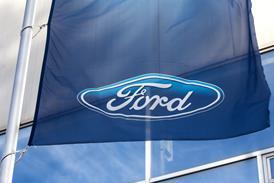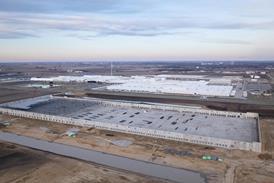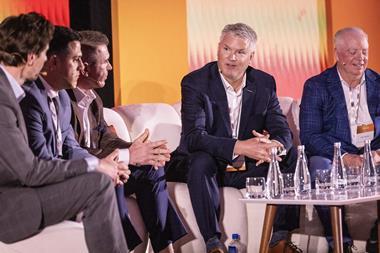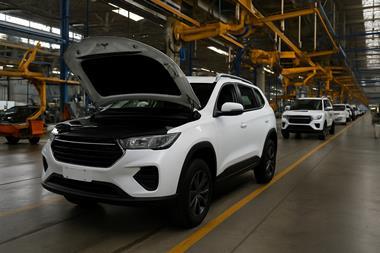As Automotive Logistics Global came to a close in Detroit, a senior level panel of logistics executives discussed themes and thoughts from the event, and looked ahead to what challenges and innovations might be in store for the sector.
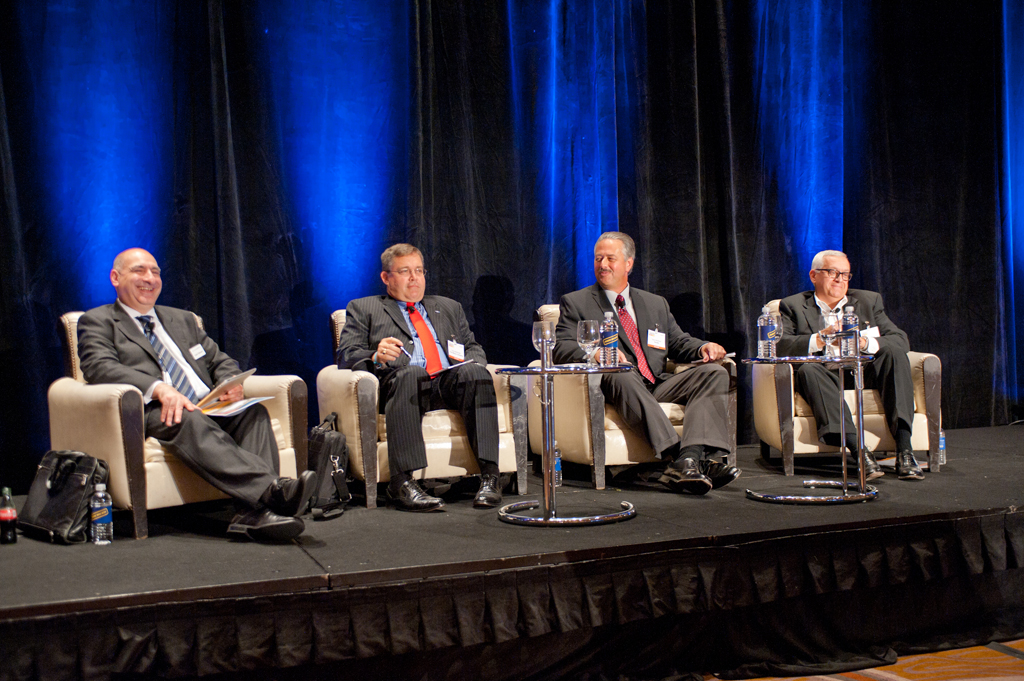
In the final session at Automotive Logistics Global 2014, senior executives reflected on the industry, discussing the future of automotive logistics and supply chain. Last year’s disruptive winter, the slow move towards greener logistics, supply chain globalisation, recruitment and technology dominated the discussions.
The panel featured Grant Belanger, global executive director of material planning and logistics and parts, service and logistics at Ford Motor Company; Dana McBrien, associate chief advisor, north America logistics at Honda; and William Cook, worldwide logistics and customs at Chrysler Group.
…on key takeaways from #ALG14
Grant Belanger, Ford: The industry is relentless, with continuous improvement, and more and more competition. As industry expands and we pursue growth, complexity increases. There is more technology, not only in operations but also across channels; but currently, while everyone uses a smartphone for personal business, it is not how people do commercial businesses. Data needs to be standardised otherwise the industry will continue to struggle.
We need to help ourselves be a competitive industry. And globalisation truly is globalisation, not regionalisation.
Dana McBrien, Honda: One key takeaway is that tier ones have a tough job. There are opportunities for us [as OEMs] to help them, but we have to be careful not to have favourites. LLPs [lead logistics providers] are in a position where they offer services and support, as a single tier one can’t do it on its own. This is a challenge for LLPs.
William Cook, Chrysler: We need to work on how we manage information and how fast. The faster we make decisions is the fundamental principle to the supply chain. There is also a big focus in other parts of the world and it’s about pulling it all together. We need to standardise processes and treat suppliers equally across the globe.
 Grant Belanger said the industry should move towards a greater standardisation of data and a real time transfer information in the supply chain
Grant Belanger said the industry should move towards a greater standardisation of data and a real time transfer information in the supply chainBelanger: There is a relentless pursuit for efficiency. Marrying that to green logistics has to deliver both. At Ford we are focused on things like zero waste to landfill [from plants], and logistics plays a role in that, including designing recyclable dunnage and packaging.
And also the efficiency in logistics, the different modes that we do, consolidation of material that create efficiencies in ecology. That is part of the process of logistics. The other thing is that we are getting longer supply chains – moving things further. I’m not sure we’re getting greener but on a mile-per-mile basis we are saving fuel per unit.
McBrien: We do a lot of things inside the design and development. Many aspects [of green logistics] have become habit, including the optimisation of logistics and reduction of miles. On the other hand, some are further ahead on alternative fuels. We haven’t ventured far into the discussion of CNG [compressed natural gas], but Honda has started to transition some – not all – of our [logistics] fleet to CNG. Because not all of our routes connect with the [fuelling] infrastructure, we are creating our own and putting a CNG filling station on site so that we can use a hub-and-spoke network. We have initiated that into our dealer network for aftermarket. We have to take that to the next level.
Cook: Initiatives like zero waste to landfill, efficient lighting etc., are all at the forefront of our strategy, not an afterthought. We have to keep track of our metrics and see what the effect is. I do also believe CNG is a viable alternative technology. Those in the [Detroit] area know that we have a fleet. The right size 12 litre engine is now available. It’s the way to go I think, but it has to be the right applications. You will see infrastructure and filling stations develop further. We’re excited about that.
…on preparing for future winters
Belanger: Climate, winter, fluctuations, these have always been a factor in our business. This past winter was atrocious. Capacity was one of the biggest issues, and the place came to a frozen halt. We haven’t lost production due to locusts yet, but everything else has come into play. We’re not going to go to buy incremental capacity because the snow might come, but we will make our network more fluid compared to last year.
McBrien: You can’t build a contingency for every eventuality, but networks need to be fluid and flexible.
Cook: Every year there are challenges. If you’re a global company with a global supply chain, you’re looking at the next tornado, or hurricane. We’ll do some practical planning and tidy up some things.
…on global regions
Belanger: There are challenges. Southeast Asia is good but there are some difficulties there. We have a new plant in India. South America needs help as the economy is not good and growth is down. Brazil is in recession so that needs some work. It’s the relentless pursuit of efficiency and every region in the world will get that attention. There is growth, and there are challenges. We have to work as much as possible on getting to a single logistics process – making the leap from today’s globalisation to true globalisation. Common practice policies and procedures will immediately drive improvement.
Cook: All regions are important. Our focus will be in Asia. We have a presence in Asia, China, Brazil, and we will maintain the US, Europe, Middle East, South America and Asia Pacific. We need to find the people with the expertise to help us grow.
…on collaboration
Belanger: We are looking to deliver efficiencies to our [members]. There’s not an LLP out there that doesn’t understand that is the baseline. Collaboration tends to be two-party to start with, then grows. We’ve collaborated with GM and other OEMs. Collaboration is there, but tactical. There is some resistance; organisations don’t want to have risk.
[sam_ad id=6 codes='true']McBrien: It is taking an awful long time. It takes a third party to put the proposals together. It’s not OEMs working together but agreeing to what is proposed.
Cook: We have had some success on our inbound network, and some success in integrating a couple of our competitors into the inbound network. It’s been a win-win – the vast majority are shared networks now. It will be a bit more difficult potentially with finished vehicles, especially at the final delivery, but we are collaborating in that area as well. We do a good job as an industry talking together. There is a group on the FVL side that meets regularly, and opportunities will present themselves through talking.
…on logistics innovation
Belanger: At the end of the day logistics is about making small improvements and tweaks, but there is room for more innovation. We have to innovate, just to stay competitive.
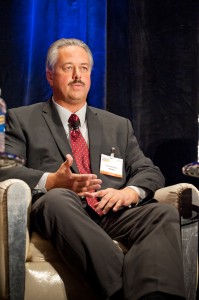 Dana McBrien said that network changes that were once considered significant are now done as a matter of course
Dana McBrien said that network changes that were once considered significant are now done as a matter of courseMcBrien: There has been rapid development with technology, and logistics programming is on the same trajectory. However, it might seem subtler to the industry when we’re making big moves. Something that might have been a big change for our network several years ago now might be made every few weeks.
Cook: We always need to be able to get the right part to the right place. We have a term in our company which is ‘reaching for discontinuity’ – a key behaviour we evaluate ourselves on. It’s about breaking the mould. We have things today that didn’t exist ten years ago because there wasn’t a need. What I like about the automotive industry, and about logistics is that we have a mass about us to innovate these things. We can create and destroy networks as we need, and we do, as a course of business. To rethink the way we do business is a matter of course. Every year, we think this the ‘latest and greatest’, and this is what we’re doing with our vehicles and our operations. We need to innovate more on the logistics side and not get complacent.
…on top business success story of the past year
Belanger: We survived the winter of 2014! Also, the team inside Ford is coming together globally, with truly global positions. That is no small feat. All eyes are on execution and continuity.
McBrien: Our biggest success is also probably one our largest challenges. We turned over how we deliver parts from Honda Motor in Japan. We’re now doing a distribution network here and letting Japan do a consolidation from multiple plants to get better efficiency. It may sound like an infancy stage step, but it is a huge leap for us. We took 35 years of how we did business [in North America] and started doing it a different way.
It was difficult. If you can imagine trying to initiate a consolidation from Japan and then distributing parts to seven facilities and having all the trains come in out of schedule because of the winter weather, it made it very challenging. However, it is now becoming more of our global standard and we are trying to initiate that from region to region within the Honda network.
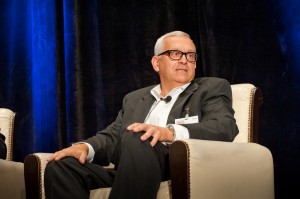
…on supply chain distance
Belanger: The relentless pursuit of efficiency doesn’t just apply to logistics, but the whole business. Economies of scale help to deliver efficiencies. As long as you can deliver on time etc., whether the supplier is far away or nearby, that’s ok. While it may not be perfect, but it’s ok for that particular set of commodities.
Cook: We track distance for all our assembly plants. Some commodities are evolving at a very economical rate from a purchasing perspective and tend to stay in certain regions, which has a knock-on effect in the supply chain.
…on giving estimated times of arrivals (ETA) to customers
Belanger: We face challenges regarding the level of accuracy, and how integrated logistics is with the sales process. We have to understand what generates customer satisfaction and we must stop dissatisfaction. We also have to understand if there is revenue in delivering vehicles to the day the customer was initially told. What is the point of promise? Will the customer pay a premium for it, or not?
We can give a very accurate ETA once the vehicle boards the conveyance in the market that it is going to sell, but not necessarily conveyance from port of exit if it’s an import. It depends on how you align your business, and what it is in terms of customer satisfaction. In the old days you always sold to the lot, but the game is changing now.
Cook: We track ETAs and how accurate we are in meeting in them as part of the metrics we have. It has been a challenge this year but we are getting back on track.
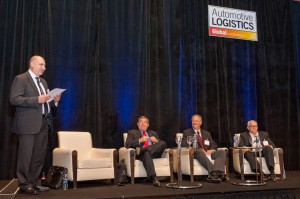
Belanger: There is potential for disruptive activity to take place. There is a lot of invested interest in logistics, including port, roads, rail, etc. There will be a lot of invested capital, so where do we get innovation around that? I’d like to try to get to an agile and flexible network capability, so as you get the signals about your [production] build, you can change the routing or change the cube utilisation without impacting the network delivery capability. That to me would be a leap over what we are doing today in terms of efficiency. That is real-time adjustment of the network and ties back into the order-to-delivery picture to make sure that we really give the customer what he wants. It is an agile network that is tied to a very fast dissemination of information.
McBrien: It’s really hard to predict based on the fast ramp-up of our industry, but one prediction I would stand by is that logistics will look different from today and won’t be a one-size fits all solution. We have to find different modes, and continue to reinvent ourselves over and over again.
Cook: There will be a standardisation of processes - we’re on that path. Look at how easy it is to get information compared to five years ago. Visibility and information are that much quicker. We will have better tools to sort out what’s hot and what’s not. We also need to continue to bring out talent, and remember that folks will have grown up with the latest technology. They have grown up with phones attached to their fingers and it will be second nature to them.
Click here for an executive summary of key themes of the Automotive Logistics Global 2014 conference.
Click here for a video recording of this panel
Click here to see video recordings of selected sessions from the conference.
Click here to follow the twitter feed from this event #alg14










